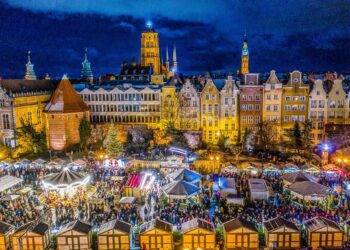In the heart of Polish culture lies Tłusty Czwartek, or Fat Thursday, a day that epitomizes the joy of communal indulgence, marking a significant moment in the calendar where culinary traditions take center stage. Celebrated on the last Thursday before Lent, this feast is deeply rooted in the customs of Poland, serving as a prelude to the period of fasting that precedes Easter. It’s a day rich with history, culinary delights, and a shared sense of community, offering a fascinating glimpse into Poland’s cultural heritage.
Tłusty Czwartek has its origins in Christian traditions, intertwined with local customs and historical practices. It marks the commencement of the last week of Carnival, a time when people indulge in food and festivities before the austerity of Lent. This tradition has evolved over centuries, embedding itself in the Polish way of life, symbolizing not only a day of feasting but also a celebration of cultural identity and familial bonds.
At the core of Tłusty Czwartek are the iconic pączki and faworki, each a symbol of culinary craftsmanship and tradition. Pączki, plump, yeast-raised doughnuts filled with jam or sweet cream and topped with powdered sugar, icing, or glaze, are the day’s stars. Faworki, known as angel wings, are thin, twisted strips of dough, fried to a crisp and dusted with powdered sugar. These treats are not just confections; they are a testament to the Polish spirit of hospitality and celebration.
Beyond the feasting, Tłusty Czwartek is a day that fosters unity and joy. Families and friends gather, sharing in the preparation and enjoyment of these traditional treats. It’s a day when the warmth of community spirit shines, as people come together, sharing not only food but also laughter and conversation. This sense of togetherness is a crucial element of the celebration, embodying the communal ethos at the heart of Polish culture.
While Tłusty Czwartek is a distinctly Polish tradition, its essence of indulgence before a period of fasting is not unique to Poland. Around the world, various cultures observe similar pre-Lenten celebrations, each with its unique customs and culinary highlights. This global tapestry of traditions underscores the universal human inclination toward celebration, feasting, and the rhythms of fasting and festivity.
Comparing Traditions: The US and UK
In the United States, the most analogous celebration is Mardi Gras, particularly famous in New Orleans. Like Tłusty Czwartek, Mardi Gras marks the culmination of the Carnival season, featuring parades, masquerades, and, of course, indulgence in rich foods. The king cake, a cinnamon-filled dough ring adorned with frosting and colored sugar, is the festive staple, symbolizing the coming of the kings for the Epiphany. While
Mardi Gras focuses more on parades and public festivities, the core idea of enjoying lavish meals and sweets before Lent mirrors the intent behind Tłusty Czwartek.
In the UK, Shrove Tuesday, known as Pancake Day, holds a similar place in the cultural fabric. On this day, Britons indulge in pancakes, a tradition stemming from the need to use up milk, eggs, and fats before the fasting period of Lent. Unlike the Polish focus on doughnuts and pastries, the British tradition leans towards simplicity and resourcefulness, with pancakes serving as a blank canvas for a variety of toppings. The day also includes unique traditions such as pancake races, where participants run while flipping pancakes in a skillet.
These celebrations, though distinct in their customs and culinary focus, share a common thread: they are a farewell to abundance before a period of moderation. Each tradition, whether it’s the pączki of Poland, the king cake of the US, or the pancakes of the UK, highlights the cultural diversity and universal nature of this period of indulgence.
Modern Celebrations and Cultural Preservation
In Poland, Tłusty Czwartek remains a testament to the enduring nature of tradition. In the age of globalization, this celebration has spread beyond Poland’s borders, with Polish communities worldwide observing the day with as much fervor as in the homeland. This global spread has not only introduced Polish culinary traditions to a wider audience but also served to preserve and reinforce cultural identity among the Polish diaspora.

Modern observances of Tłusty Czwartek blend tradition with innovation, as new variations of pączki and faworki emerge, and social media platforms buzz with photos and stories of celebratory feasts. Yet, at its core, the day remains a symbol of the continuity of culture, a time for honoring the past while embracing the present.
Tłusty Czwartek, with its rich tapestry of history, tradition, and culinary excellence, stands as a vibrant celebration of Polish culture. It is a day that transcends the mere act of eating, embodying the spirit of joy, community, and cultural pride. Comparing it with similar traditions in the US and UK highlights not only the uniqueness of each culture’s approach to this pre-Lenten period but also the shared human desire for celebration and reflection.
As we observe these traditions, whether through participation or observation, we gain a deeper appreciation for the diverse ways in which cultures around the world mark the cyclical nature of feasting and fasting. Tłusty Czwartek, in all its indulgent glory, invites us to partake in a moment of communal joy, reminding us of the enduring power of tradition to bring people together.


















